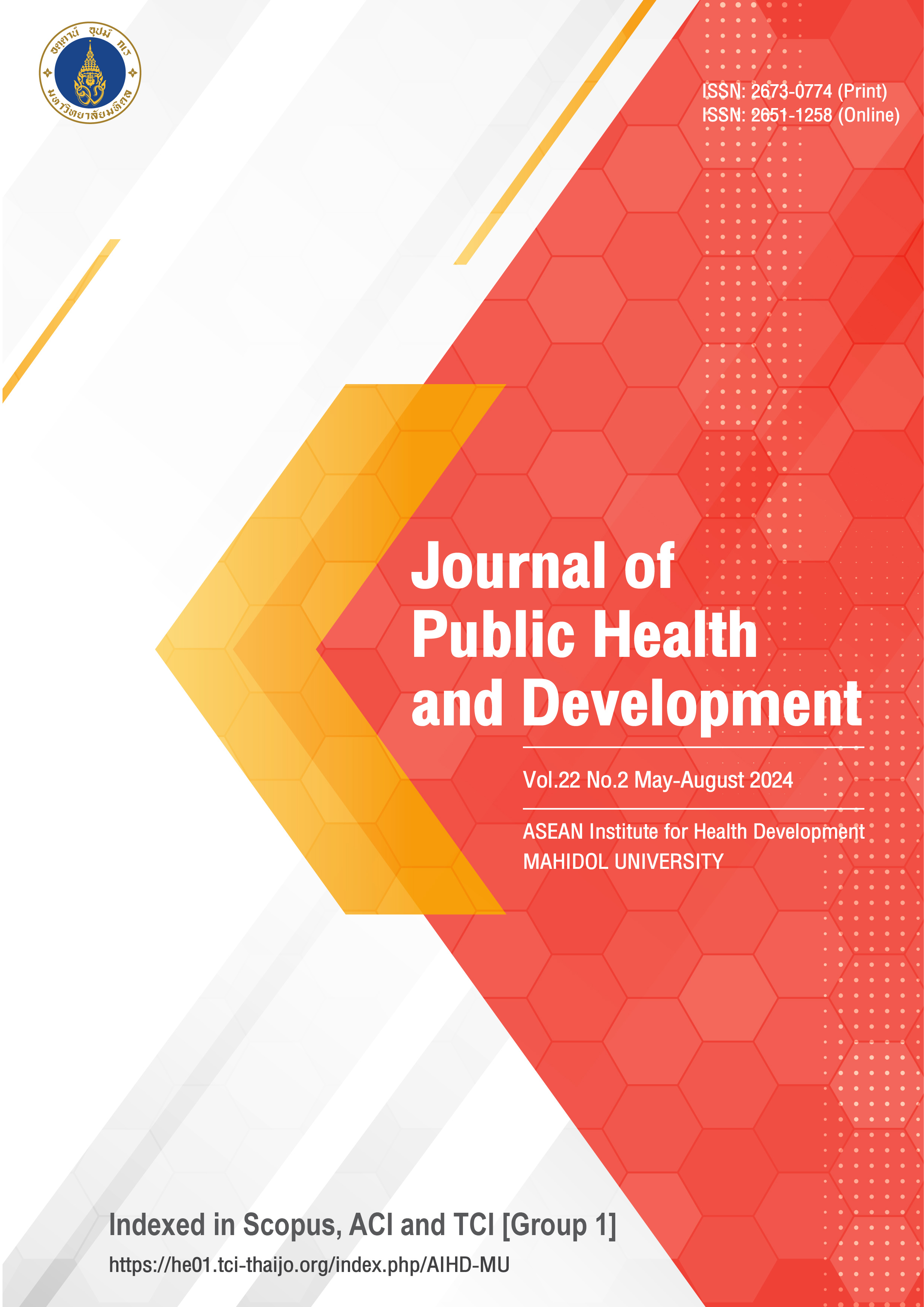Comparison of the effect of isotonic and hypotonic saline solutions for children with mild dehydration at Lampang Hospital 10.55131/jphd/2024/220220
Main Article Content
Abstract
Administering the appropriate type and rate of fluids is crucial for pediatric patients. Young patients should be given isotonic solutions, as they are safer than hypotonic solutions for fluid maintenance. However, limited studies exist on the efficacy and complications of isotonic solutions for treating acutely ill pediatric patients with mild dehydration. This study aimed to compare isotonic and hypotonic solutions in such cases. A stratified randomized controlled trial was conducted on patients aged 6 months to 15 years with acute illness and mild dehydration in two disease groups: acute gastroenteritis and other diseases. The trial involved administering intravenous fluids, either isotonic or hypotonic solution, for at least 24 hours. Pre and post-treatment serum sodium levels and treatment complications were assessed and compared between patients who received isotonic and hypotonic solutions. A total of 144 patients were randomly assigned to receive either isotonic solution or hypotonic solution. Of the 144 patients, 72 received isotonic and 72 received hypotonic solutions. The isotonic group comprised 51.4% males with a median age of 27.5 months. On the other hand, the hypotonic group comprised 56.9% males with a median age of 38 months. At baseline, both groups' sodium levels were similar at 136.2±2.5 and 136.8±2.5 mmol/L, respectively. After 24 hours, the isotonic group had a statistically significant increase in sodium levels (138.8±2.2 mmol/L; increased median 2.3) compared to the hypotonic group (138.1±2.0 mmol/L; increased median 1.5). In conclusion, no cases of hypernatremia, drowsiness, or seizures were observed, suggesting isotonic solutions can be safely used in these selected groups of acutely ill pediatric patients with mild dehydration.
Article Details

This work is licensed under a Creative Commons Attribution-NonCommercial-NoDerivatives 4.0 International License.
References
Farrell C, Del Rio M. Hyponatremia. Pediatr Rev. 2007;28(11):426-8. doi: 10.1542/pir.28-11-426.
Holliday MA, Segar WE. The maintenance need for water in parenteral fluid therapy. Pediatrics. 1957;19(5):823-32.
Kliegman R, Behrman R, Jenson H, Stanton B (eds). Nelson textbook of pediatrics, 18th. ed. Saunders Elsevier, Philadelphia. P. 309-16.
Torres SF, Iolster T, Schnitzler EJ, Siaba Serrate AJ, Sticco NA, Rocca Rivarola M. Hypotonic and isotonic intravenous maintenance fluids in hospitalised paediatric patients: a randomised controlled trial. BMJ Paediatr Open. 2019;3(1):e000385. doi: 10.1136/bmjpo-2018-000385.
Hasim N, Bakar MAA, Islam MA. Efficacy and Safety of Isotonic and Hypotonic Intravenous Maintenance Fluids in Hospitalised Children: A Systematic Review and Meta-Analysis of Randomised Controlled Trials. Children (Basel). 2021;8(9). doi: 10.3390/children8090785.
Edelson JB, Orenstein EW, Zaoutis LB, Copelovitch L. Intravenous Fluid Management in the Pediatric Hospital Setting: Is Isotonic Fluid the Right Approach for all Patients?. Curr Treat Options Peds. 2015;1:90–9.
Feld LG, Neuspiel DR, Foster BA, Leu MG, Garber MD, Austin K, et al. Clinical Practice Guideline: Maintenance Intravenous Fluids in Children. Pediatrics. 2018;142(6). doi: 10.1542/peds.2018-3083.
Hanna M, Saberi MS. Incidence of hyponatremia in children with gastroenteritis treated with hypotonic intravenous fluids. Pediatr Nephrol. 2010;25(8):1471-5. doi: 10.1007/ s00467-009-1428-y.
Neville KA, Verge CF, Rosenberg AR, O'Meara MW, Walker JL. Isotonic is better than hypotonic saline for intravenous rehydration of children with gastroenteritis: a prospective randomised study. Arch Dis Child. 2006;91(3):226-32. doi: 10.1136/adc. 2005.084103.
Sánchez-Bayle M, Martín-Martín R, Cano-Fernández J, Villalobos-Pinto E. Fluid therapy and iatrogenic hyponatraemia risk in children hospitalised with acute gastroenteritis: prospective study. Nefrologia. 2014; 34(4):477-82. doi: 10.3265/Nefrologia .pre2014.May.12257.
Golshekan K, Badeli H, Miri M, Mirzaie M, Hassanzadeh Rad A, Salamat F, et al. Suitable intravenous fluid for preventing dysnatremia in children with gastroenteritis; a randomized clinical trial. J Renal Inj Prev. 2016;5(2):69-73. doi: 10.15171/ jrip.2016.15.
Choong K, Kho ME, Menon K, Bohn D. Hypotonic versus isotonic saline in hospitalised children: a systematic review. Arch Dis Child. 2006; 91(10):828-35. doi: 10.1136/adc.2005. 088690.
Moritz ML, Ayus JC. Prevention of hospital-acquired hyponatremia: do we have the answers? Pediatrics. 2011;128(5):980-3. doi: 10.1542/peds. 2011-2015.
Moritz ML, Ayus JC. Hospital-acquired hyponatremia--why are hypotonic parenteral fluids still being used? Nat Clin Pract Nephrol. 2007;3(7):374-82. doi: 10.1038/ncpneph0526.
Yung M, Keeley S. Randomized controlled trial of intravenous maintenance fluids. J Paediatr Child Health. 2009;45:9-14.
Neville KA, Sandeman DJ, Rubinstein A, Henry GM, McGlynn M, Walker JL. Prevention of hyponatremia during maintenance intravenous fluid administration: a prospective randomized study of fluid type versus fluid rate. J Pediatr. 2010;156(2):313-9.e1-2. doi: 10.1016/j.jpeds.2009.07. 059.
Montañana PA, Modesto i Alapont V, Ocón AP, López PO, López Prats JL, Toledo Parreño JD. The use of isotonic fluid as maintenance therapy prevents iatrogenic hyponatremia in pediatrics: a randomized, controlled open study. Pediatr Crit Care Med. 2008;9(6):589-97. doi: 10.1097/PCC.0b013e31818 d3192.
Kannan L, Lodha R, Vivekanandhan S, Bagga A, Kabra SK, Kabra M. Intravenous fluid regimen and hyponatraemia among children: a randomized controlled trial. Pediatr Nephrol. 2010;25(11):2303-9. doi: 10.1007/s00467-010-1600-4.
Coulthard MG. Will changing maintenance intravenous fluid from 0.18% to 0.45% saline do more harm than good? Arch Dis Child. 2008;93(4):335-40. doi: 10.1136/adc. 2007.124461.






